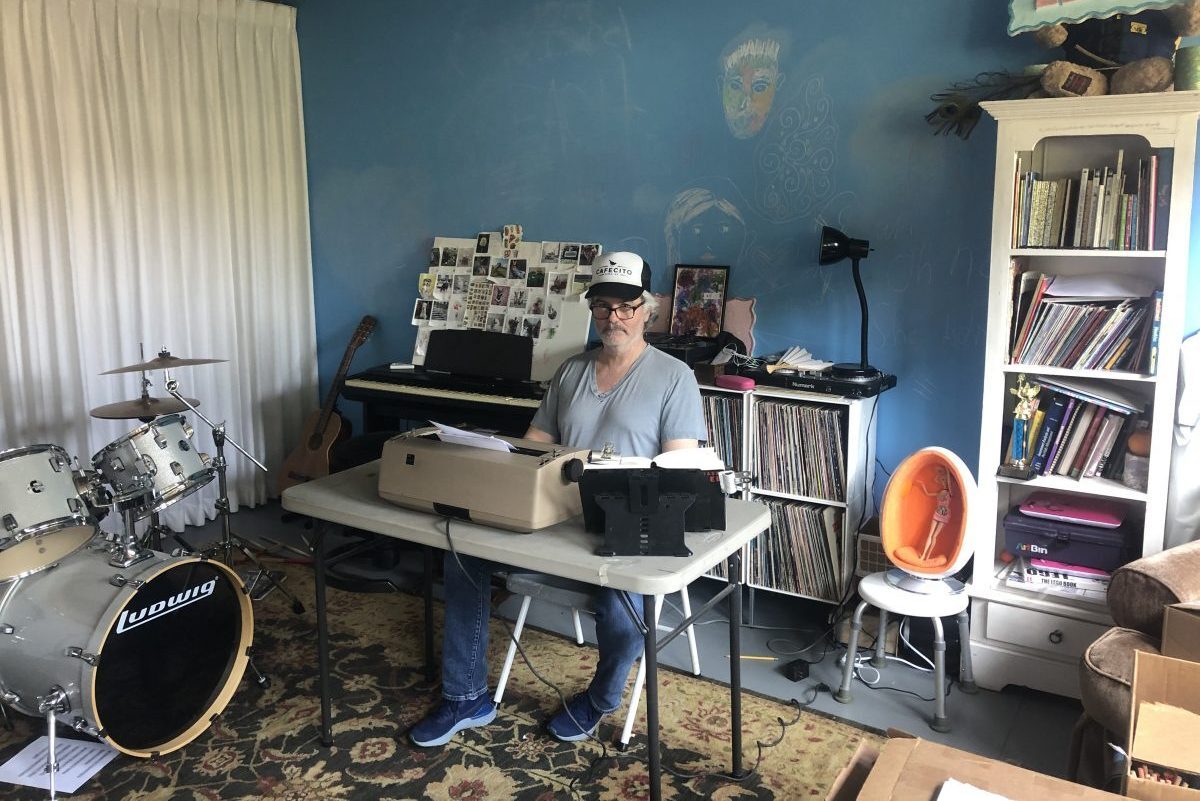Tim Youd knows what he’ll be doing for the next month of COVID. “For me,” he says from his Los Angeles home, “it’s a compulsion to make art, and I’m very grateful to have a chance to devote myself to my compulsion—re-typing one novel for a month.”
The novel is William Gass’s The Tunnel. Published in 1995, it is a 650-page postmodern tome, weighty in terms of metaphor, theme, and heft. “Gass was deeply into metaphor,” says Youd of one of St. Louis’s and the world’s late literary lions. “He was as much a philosopher as a fiction writer. In this book he was thinking about weight. He chose to write a book measured in pounds.” It’s a hard book to read physically—you can’t comfortably rest it on your chest in bed—and it is challenging in terms of understanding, following along, deciphering. The Tunnel is a novel of difficulty, weight, and rigor, which Youd finds ideal for our current situation. “I thought how it’s a lot of work to be in quarantine—a weight is collecting upon us.” It’s also “a book about being trapped,” he adds, “trapped by one’s self, in the life one’s constructed, trapped in one’s mind, one’s words and thoughts.” A book that is its own stay-at-home order.
Beginning Friday, May 1, 11:00 am CT, Youd will begin retyping The Tunnel. As he has done in performances that go back to 2013, he will retype the entire novel on one sheet of paper, with another sheet of paper as backing. When he reaches the bottom margin of the page he goes back to the top and types over what he typed before. Youd expects to complete The Tunnel in thirty-one days, typing around seven hours a day, with breaks for lunch. The performance will be streamed live on YouTube, and each Friday at 1:00 pm CT, the artist will be visited by a guest close to the project on Instagram Live: Lisa Melandri and Misa Jeffereis, executive director and assistant curator of CAM, respectively; Allison Unruh, Brooklyn-based, independent curator and former associate curator of the Mildred Lane Kemper Art Museum; and Cristin Tierney, director of her eponymously named New York City gallery, which represents Youd. Viewers are invited to send in questions. From May 1 through May 31, you may keep track of Youd’s progress at tunnelretyped.com.
The Tunnel is No. 67 in Youd’s ongoing 100 Novels project. Youd has retyped William Faulkner’s The Sound and the Fury in the author’s Mississippi home, Raymond Chandler’s Farewell My Lovely on Santa Monica Pier, and Virginia Woolf’s Orlando at Monk’s House, her home in Sussex. Youd’s exhibition at CAM in spring 2018, St. Louis Retyped, included his two-dimensional typewriter drawings and a series of performances at the Museum and at locations related to four writers with St. Louis histories: William S. Burroughs, T.S. Eliot, Stanley Elkin, and Marianne Moore. Youd retyped Eliot’s Collected Poems at CAM; Moore’s Complete Poems at First Presbyterian Church of Kirkwood, Tree of Life Chapel, where the poet lived as a young girl; and Burroughs’s Naked Lunch at the author’s boyhood home, at Left Bank Books where he gave his last St. Louis reading, and at his gravesite in Bellefontaine Cemetery. When the performances were completed, the top sheet and undersheet of paper, battered, torn, and heavily inked, were framed and placed in CAM’s front gallery as diptychs, as the residue of performance, and as condensations of the actual books.
Youd retyped Elkin’s The Franchiser at two locations on the Washington University in St. Louis campus, where Elkin and Gass taught for many years together. “The school has an incredible collection of postmodern writers—Elkin, Gass, Joy Williams, William Gaddis—as well as many of their typewriters,” Youd recalls. “I corresponded with Gass’s wife Mary, who advised me on Gass’s writing habits.” Gass wrote The Tunnel over a period of 26 years, “and at least during the latter of those years, on an IBM Selectric,” Youd tells me. The artist retypes the books on the typewriter models upon which they were composed.
While Youd was in St. Louis in 2018, he was invited by Joel Minor, curator of Modern Literature Manuscripts at Washington University, to view the special collection manuscripts. At the time, Youd had read some of Gass’s short stories and his early novel, Omensetter’s Luck, but not The Tunnel. “Then I saw some of the typed manuscript of The Tunnel and I was very excited. Gass had used various colored inks and fonts. The manuscript was a thing itself. I read a little bit of the novel and I loved it from the get-go. I would have loved to have typed the book in St. Louis—I thought I blew it!”
Then just a few weeks ago, while quarantined at home with his family, Youd wondered, “What if I propose to CAM an extension of my earlier project with them, and connect St. Louis to Los Angeles through Gass himself.” Not only did Gass live in St. Louis for decades, he completed The Tunnel while on a residency at the Getty Research Center in Los Angeles. This virtual St. Louis-Los Angeles bridge is symbolically built by a book that contains “metaphors with all the threads we’re grasping at.” Youd’s performative act would be akin to “tunneling out of the quarantine.”
The Tunnel will be the artist’s longest performance, at least up to now. “I’m planning on retyping Don DeLillo’s Underworld and Thomas Pynchon’s Gravity’s Rainbow,” Youd says. “All the King’s Men took 23 days. Art doesn’t always have to hurt, but sometimes it does. I have two Selectrics a typewriter repairman I work with recently returned to me fully tuned. Selectrics have some power and they don’t like thick paper, which will create some challenges. If one typewriter breaks down I can move to the next one while sending the other back for repairs. I hope I can keep the two typewriters going.”
—Eddie Silva
